|
THE ‘Forty-five proved to
be the end of civil strife in our country, for, whatever wars Britain
might wage abroad, the people were determined to have settled and ordered
government at home. In no other way could trade flourish and progress be
made. From the period of the ‘Forty-five, then, a wonderful change came
over Scotland. Instead of nursing her wrongs as she had hitherto done, she
now began to realize, and to take advantage of, the many benefits and
opportunities the Union had really put in her way. The two peoples did not
love each other any the more. The notorious John Wilkes, a few years after
this time, stirred up in the hearts of Londoners strong feelings of hatred
and contempt against all Scotsmen for the share the Marquis of Bute had in
the unpopular Treaty of Paris which closed the Seven Years’ War. Every
year as the king or queen’s birthday came round, almost right down to
the close of Queen Victoria’s reign, the Leithers, at first from revenge
and later from custom, would burn John Wilkes in effigy under the name of Wully
Wulks, because they had really forgotten who he was.
Up to this time Leith had
practically not grown beyond her mediaeval bounds. Farming was still an important
occupation of its inhabitants. Fields of pease, oats, and barley occupied
all the land between St. Anthony’s Port and the Netherbow. In Easter
Road still stand the farm-house and steading of Lower Quarry Holes, whose
tenant, Robert Douglas of Coatfield, in 1730, like so many indwellers of
Leith, under the name of maltman combined the vocations of farming and
brewing, and was a member of the Burlaw Court, which met in the Doocot
Park beside the Links. But just after the period of the ‘Forty-five a
change began to show itself in the landscape viewed from Leith. Turnips,
soon to be followed by potatoes, now became a field crop. To protect these
crops from the wandering cattle the fields had to be enclosed by dikes and
hedgerows.
Farmers had no longer to
slaughter their cattle for lack of winter food for them after the stubble
fields had been eaten bare. They could now be fed on turnips. Salt meat,
varied with pigeon pie, then ceased to be the winter fare of the people of
Leith, as it had been for centuries; and the dovecots in the gables of the
houses, around which pigeons were ever cooing and fluttering, now became
silent and untenanted, and were put to other uses. A few of these old
dovecot gables, with their alighting ledges and entrance holes for the
birds yet survive in Leith, as at 32 Shore, and remind us of the days when
food was less plentiful than with us now, and pigeons had to be kept to
eke out, and to add variety to, the winter supply.
Leith now began to advance
with steady progress and has continued to do so down to the present time;
for although Britain was almost constantly engaged in wars on the
Continent during the second half of the eighteenth century, these did not
injure Leith’s trade to anything like the extent that England’s wars
with France and Holland had done during the century before. Then Leith’s
overseas commerce was almost her only trade, but now, in the latter half
of the eighteenth century, she had many home industries as well as foreign
trade. The raw material for her manufactures she imported mostly from the
Baltic—a trade route on which Leith vessels were not likely to encounter
so many of the enemy’s warships and privateers as in the days when her
commerce was chiefly with the Netherlands. Furthermore, throughout the
long French war the Government, at the suggestion of the Leith and
Edinburgh merchants, among whom Mr. Gladstone’s grandfather took the
lead, encouraged neutral vessels to bring in cargoes of raw material
necessary for our home industries even from enemy countries, a policy by
which the linen factories of Edinburgh and the Leith sail-cloth works and
rope-walks were enabled to carry on all through the war.
During the first
twenty-five years after the ‘Forty-five Leith’s shipping trade
increased sevenfold. That was due to several causes, one of which was that
new industries, like the oil-works of Messrs. P. and C. Wood and the new
sugar-house in Water Street, were constantly being founded, and old ones,
like the glass-works and the shipbuilding yards, being further extended
and developed. At the beginning of the nineteenth century the glass-works
had increased from two to seven.
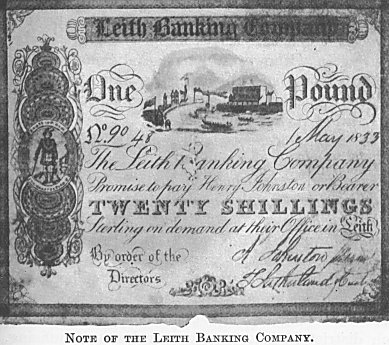 This
noteworthy industrial and commercial expansion was due mostly to two
factors, without whose aid it could not have taken place; the one was the
rise and development of banks, and the other was the Turnpike Road Act of
1751. The first of the great banking companies to open a branch in Leith
was the British Linen company, which, as its name indicates and as its
more recent note issues show, was first founded as a linen company, and
then forsook trading in linen to take up banking; but the Leith Banking
Company had already built and established itself in the neat little domed
building in Bernard Street, now occupied by the National Bank. It failed
in 1842, and had to close its doors. It was followed by the Edinburgh and
Leith Banking Company, a very wealthy corporation, now merged in the
Clydesdale Bank. Money was very scarce in Edinburgh and Leith in the
eighteenth century. To the credit system of these banks, by which Leith
merchants were able to finance their transactions, is largely due the
Position of the Port in the world of commerce to-day. This
noteworthy industrial and commercial expansion was due mostly to two
factors, without whose aid it could not have taken place; the one was the
rise and development of banks, and the other was the Turnpike Road Act of
1751. The first of the great banking companies to open a branch in Leith
was the British Linen company, which, as its name indicates and as its
more recent note issues show, was first founded as a linen company, and
then forsook trading in linen to take up banking; but the Leith Banking
Company had already built and established itself in the neat little domed
building in Bernard Street, now occupied by the National Bank. It failed
in 1842, and had to close its doors. It was followed by the Edinburgh and
Leith Banking Company, a very wealthy corporation, now merged in the
Clydesdale Bank. Money was very scarce in Edinburgh and Leith in the
eighteenth century. To the credit system of these banks, by which Leith
merchants were able to finance their transactions, is largely due the
Position of the Port in the world of commerce to-day.
When we read in Macaulay’s
glowing pages of the adventures and mishaps of travellers like the
restless and gossipy Pepys while journeying along the wretched English
roads of the seventeenth and eighteenth centuries, we seldom realize that
the very same experiences were being met with on the sorry tracks that
passed for roads around Leith during the same period. When Sir John Foulis
and his friends drove in his great lumbering coach from Ravelston to the
horse-races on Leith Sands, they considered themselves lucky indeed if
they arrived home again without the carriage sticking fast in some hole,
or, worse still, breaking an axle. Axle-trees are frequent items of
expense in the old account books of the Laird of Ravelston.
When this old Scots laird
sent one of his estate carts to Leith, perhaps to the Vaults, to have the
wine cellar at Ravelston replenished, he had always to count upon so many
of the bottles being broken and their contents lost owing to the constant
jolts from holes and ruts. Thus in January 1700 four bottles of brandy out
of three dozen were lost in this way. Goods had accordingly to be carried
in small loads on the backs of horses, just as had been done in medieval
times. Trade could never expand so long as such conditions prevailed,
because each district had to be more or less self-sufficing, and provide
for its own needs. But all this was changed in 1751 by the Turnpike Road
Act, which, next to railways and the steam-engine, has done most to
promote Scotland’s trade.
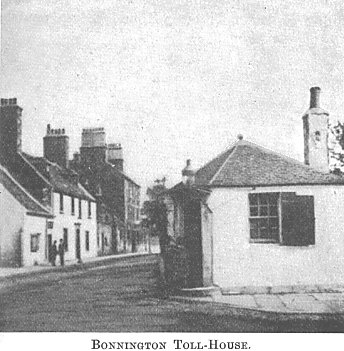 A
turnpike was a tollgate or tollbar set across a road to hold up carts and
carriages until the toll for the upkeep of the road was paid. From this
tax, what had before been impassable tracks now were made excellent!
roads, opening up communication with every district, and enabling carts
with many times the load of a pack-horse to pass along with ease. By the
Turnpike Road Act Leith’s trade area was largely extended, and this had
much to do with the wonderful expansion in her shipping trade in the
latter half of the eighteenth century. Let us illustrate this expansion
due to better roads by one example. In 1779 a Leith wholesale grocer, Mr.
Charles Cowan, carrying on business in the Tolbooth Wynd in the shop now
occupied by Messrs. Buchan and Johnston, removed to Penicuik, and began
papermakjng in mills which have since grown to be among the largest in the
world. Their export and import trade was done through Leith owing to the
improved roads, as it is so largely done to-day, and by the same means. A
turnpike was a tollgate or tollbar set across a road to hold up carts and
carriages until the toll for the upkeep of the road was paid. From this
tax, what had before been impassable tracks now were made excellent!
roads, opening up communication with every district, and enabling carts
with many times the load of a pack-horse to pass along with ease. By the
Turnpike Road Act Leith’s trade area was largely extended, and this had
much to do with the wonderful expansion in her shipping trade in the
latter half of the eighteenth century. Let us illustrate this expansion
due to better roads by one example. In 1779 a Leith wholesale grocer, Mr.
Charles Cowan, carrying on business in the Tolbooth Wynd in the shop now
occupied by Messrs. Buchan and Johnston, removed to Penicuik, and began
papermakjng in mills which have since grown to be among the largest in the
world. Their export and import trade was done through Leith owing to the
improved roads, as it is so largely done to-day, and by the same means.
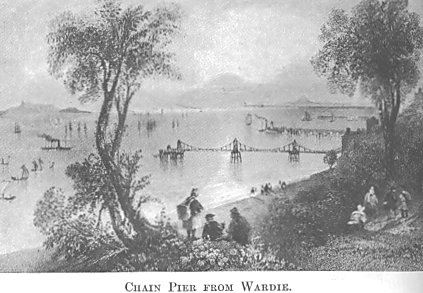 It
was only after the Turnpike Road Act came force that travelling began to
be common, because it could now be done with comparative ease and comfort.
Down to the middle of the eighteenth century, save an occasional coach to
London at long and irregular intervals, the only stage coaches in Scotland
were the two huge clumsy-looking vehicles that ran between Leith and
Edinburgh by the Easter Road. Stage coaches now began to travel regularly
on all the main roads, and, in connection with these, ferry and passenger
boats ran at regular and stated times to the various ports on the Forth,
from Leith and Newhaven, and later, when steam-packets came into use, from
the Chain Pier just beyond Newhaven, which was erected in 1821. With the
introduction of railways most of the steamers plying up and down the Forth
disappeared, and the ferry boats from Newhaven were transferred to Granton. It
was only after the Turnpike Road Act came force that travelling began to
be common, because it could now be done with comparative ease and comfort.
Down to the middle of the eighteenth century, save an occasional coach to
London at long and irregular intervals, the only stage coaches in Scotland
were the two huge clumsy-looking vehicles that ran between Leith and
Edinburgh by the Easter Road. Stage coaches now began to travel regularly
on all the main roads, and, in connection with these, ferry and passenger
boats ran at regular and stated times to the various ports on the Forth,
from Leith and Newhaven, and later, when steam-packets came into use, from
the Chain Pier just beyond Newhaven, which was erected in 1821. With the
introduction of railways most of the steamers plying up and down the Forth
disappeared, and the ferry boats from Newhaven were transferred to Granton.
Besides the stage coaches
supplying the needs of the passenger traffic on the Forth, there were the
royal mail coaches, which carried the mails as well as passengers. Many of
the coaches started from the Black Bull Hotel, Leith Street, a building in
which is now housed the confectionery establishment of Messrs. Duncan. In
the early decades of the nineteenth century, coaching’s primest age, it
was a brave sight, on a summer morning, to see the stage coach for Perth
and the North, with its four spanking horses, leave the Black Bull for the
ferry boat at Newhaven, the guard in red coat and beaver hat tooting
melodiously on his long horn as the horses set off down Leith Street.
Swinging round into Broughton Street, they were wont to go down the hill
in dashing style, the outside passengers steadying themselves by clutching
the guard irons as coach and horses careered down the steep descent
towards Newhaven.
But the days of the stage
coach were numbered. A rival was about to enter into competition with it
for the passenger traffic of the country. This was the locomotive engine.
While George Stephenson was constructing his Rocket, an ingenious
Leith residenter, Timothy Burstall by name, engineer at Leith Sawmills
above Junction Bridge, was building his engine, the Perseverance. Burstall
took the Perseverance to Manchester in 1829 to compete against
Stephenson’s Rocket for the prize of £500 offered by the
Liverpool and Manchester Railway Company. The Perseverance failed
to carry off the prize, but it was highly commended. Railways now began to
spread over the land. The Edinburgh, Leith, and Granton Railway was opened
in 1848, and the stage coach ere long became one of the things that had
been.
To the passenger traffic
from the Shore we owe the old Leith inns—the Britannia, the Old Ship,
and the New Ship. The Old Ship Hotel, built in 1676, was burned down in
1888, but was rebuilt, and is the only one of the three still open to-day.
The carved stones of the old building, together with its ancient sign,
adorn its present-day successor. It was in front of the "Old
Ship," as an inscription plate in the quay wall reminds us, that
George IV. landed in Scotland in 1822. The doorway of the New Ship Inn is
shown, exactly as it is to-day, in the old picture of the harbour in the
Trinity House.
Perhaps the most
fashionable Leith tavern during the latter half of the eighteenth century
was Straiton’s in the Kirkgate, opposite Laurie Street. The Kirkgate,
which we may call the High Street of Old Leith, was not then the
comparatively broad street it is to-day, but was still the narrow alley
the defensive needs of medieval times had made it. Its high-peaked gables
and numerous timber fronts jutting over the dingy booths or shops beneath
gave this street all that picturesque variety of outline so dear to our
forefathers
"Of the old days, and
the old ways,
And the world as it used to be."
Laurie Street was still
unbuilt. On its site grew a line of shady elms, while harvest-fields
stretched to the links, and on the south joined those of Quarryholes farm
and Pilrig. As it stood in close proximity to the Links, Straiton’s Inn
was a favourite resort of golfers. It was here, in all likelihood, that
the strange yet merry dinner and ball described in Smollett’s Humphry
Clinker were held.
Straiton’s always housed
a gay and aristocratic crowd during the week of the Edinburgh Race
Meeting. which was held annually on Leith Sands, then, strange as it may
seem, the most popular race-course in Scotland. These races are usually
said to date from the Restoration period, but Leith was noted both for
inns and horse-races centuries before then. In the Lord High Treasurer’s
accounts for the reign of James IV., entries like the following may be
read: "To the wife of the king’s inn, and to the boy that ran the
king’s horse at Leith, xxviii s." Sometimes this horse was King
James’s favourite steed, Grey Gretno. In 1816 the Race Meeting was
transferred to Musselburgh, where it has been held ever since.
 In
the seventeenth and eighteenth centuries much fancy was displayed in the
decoration of doorways when the rest of the building was left unadorned.
Several interesting specimens are to be found on the Shore. There is the
doorway to Mylne’s Land; another with a highly intricate monogram and
the date 1711 that must have given entrance to the King’s Wark; and the
doorway to the New Ship Inn. Over this doorway, in Latin, is inscribed a
verse from the 121st Psalm, most ingeniously adapted, by the alteration of
a word, to the calling of the house—" He that keepeth thee will not
slumber. Behold, he that keepeth the house shall neither slumber
nor sleep." The introduction of railways made Edinburgh the chief
place in our district for the arrival and departure of travellers, and
then the old-fashioned hostelries on the Shore were forsaken for the
palatial hotels that arose in Princes Street. In
the seventeenth and eighteenth centuries much fancy was displayed in the
decoration of doorways when the rest of the building was left unadorned.
Several interesting specimens are to be found on the Shore. There is the
doorway to Mylne’s Land; another with a highly intricate monogram and
the date 1711 that must have given entrance to the King’s Wark; and the
doorway to the New Ship Inn. Over this doorway, in Latin, is inscribed a
verse from the 121st Psalm, most ingeniously adapted, by the alteration of
a word, to the calling of the house—" He that keepeth thee will not
slumber. Behold, he that keepeth the house shall neither slumber
nor sleep." The introduction of railways made Edinburgh the chief
place in our district for the arrival and departure of travellers, and
then the old-fashioned hostelries on the Shore were forsaken for the
palatial hotels that arose in Princes Street.
For centuries, as has been
seen, Leith was the principal gateway into and out of the country. Within
the last century Glasgow has, of course, become the largest port in
Scotland. But while Glasgow has, almost mushroom-like, grown to be the
greatest Scottish port and the centre of the vast trade with the American
continent, Leith has
maintained its position as the principal channel for the trade and
commerce of this country and the northern parts of Ireland with the
various countries bordering the North Sea, as well as with the numerous
ports located on the Baltic and White Seas.
As has been seen, a great
increase in the traffic passing through Leith took place in the second
half of the eighteenth century. In 1763 the shore dues collected upon the
goods landed and shipped amounted to £580. Within twenty years this had
increased as nearly as possible sevenfold. The monetary value of the trade
of Leith in 1784 was estimated at £495,000, carried on by forty different
traders or companies. The more important commodities dealt in were grain,
flax, hemp, wood, tar, iron, and food-stuffs; while the manufactures
included ropes, canvas, soap, and candles. It is officially recorded
that in 1794 the number of vessels belonging to the Port of Leith was 144,
of an aggregate tonnage of 15,504, the men forming the crews numbering
854. Compared with the figures pertaining to more recent times these seem
insignificant. Thus the tonnage of Leith’s ships at the outbreak of the
Great War in 1914 was 254,082. And even these figures are far from
indicating the increase in Leith’s shipping facilities, for as each
steamship makes several voyages to every one of a sailing vessel the
latter figure ought to be multiplied six or even more times to give a true
comparison.
Up to the close of the eighteenth
century much of the commerce of Leith was conducted in brigs. These were
vessels of considerable size for those days, say from 160 to 200 tons
burden. The important and growing trade between the Thames and the Forth
was carried on by them. In some respects, however, they were not wholly
suitable for the business, and about 1790 a movement began to displace
them by rather smaller but handier craft called smacks. These soon
acquired wide renown, and proved so suitable for the conveyance of both
passengers and goods that within some twenty years there had been formed
to engage in the Leith and London trade four companies, which owned
between them twenty-seven fine vessels. One of these, the London and
Edinburgh Shipping Company, still carries on this service with admirable
energy, and, of course, with vessels of the most modern description. A
model of the Comet, a smack once owned by this Company, may be seen
within one of their office windows in Commercial Street.
Of these smacks and their
encounters with the French Privateers which then infested the North Sea in
large numbers, many stirring tales are told. For these were the days of
the Napoleonic wars, and even peaceful merchantmen were armed with
carronades—so called from being made at the Caron Ironworks—and their
crews were kept well drilled and ready to repel the attacks made upon
them. On one occasion in 1805 a privateer falling in with one of these
smacks, the Swallow, opened fire upon her, doubtless relying upon
an easy capture of a fairly valuable prize. For the result the Frenchmen
could hardly have been prepared, as the gallant Leithers replied with such
spirit and to so good effect that the enemy was fain to abandon the fight
and to thaw off in a crippled condition without having damaged the smack
in any way.
Such encounters as the Swallow
were of very common occurrence all through the wars of the eighteenth
century, and show the stuff of which Leith captains and mariners of those
times were made. But the Leith sailormen, in the long and strenuous fight
against Napoleon, did more than merely defend their ships when attacked.
In 1795 the ship captains of the Port, to the number of one hundred and
twenty, offered to serve their country at sea in any capacity suitable to
their position, while two hundred Newhaven fishermen manned the gunship Texel.
and, capturing the French frigate Neyden, returned to Newhaven
in triumph. As we shall see later, when occasion called, the same
indomitable courage was not lacking on the part of her modem sailormen in
the Great War.
To aid in the defence of
Leith if an attack should be made, the Martello Tower was built in 1809.
Leith Fort, upon which the chief burden of defence would have lain, had
been constructed in 1779 after the confusion and tenor of the threatened
attack on the Port by Paul Jones and his three warships. Happily no
occasion arose to test the efficiency of these works for the purpose for
which they were erected.
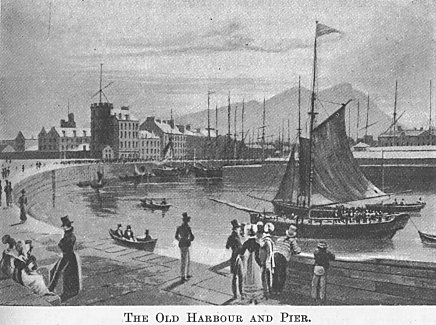 It
has already been mentioned that a large expansion of the trade and
commerce of the Port had been taking place for a considerable time prior
to 1800. Up till then Leith possessed no docks. The ships came into the
harbour and lay alongside the quay wall that lined the river bank. This,
as its shipping business extended, became more and more an intolerable
condition of affairs. It also suffered great inconvenience from the
existence of a bar at the harbour mouth, which confined to a comparatively
short period at the top of high-water of each tide the time during which
craft of any but the smallest size could enter or leave. The result was
that two wet docks were constructed on the west side of the harbour which
provided accommodation for about one hundred and fifty vessels of the size
then generally trading with Leith. It
has already been mentioned that a large expansion of the trade and
commerce of the Port had been taking place for a considerable time prior
to 1800. Up till then Leith possessed no docks. The ships came into the
harbour and lay alongside the quay wall that lined the river bank. This,
as its shipping business extended, became more and more an intolerable
condition of affairs. It also suffered great inconvenience from the
existence of a bar at the harbour mouth, which confined to a comparatively
short period at the top of high-water of each tide the time during which
craft of any but the smallest size could enter or leave. The result was
that two wet docks were constructed on the west side of the harbour which
provided accommodation for about one hundred and fifty vessels of the size
then generally trading with Leith.
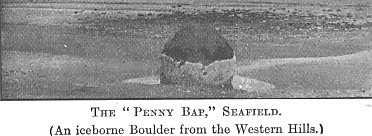 This
work was begun in 1800, and, including two dry docks, was only completed
in 1817. The formation of these docks involved the destruction of an old
Leith landmark, a great rock even larger than the "Penny Bap" at
Seafield. This shell-covered rock, which lay on the sands just off the
Citadel, was known as Shellycoat, and according to the superstitious was
the haunt of a demon who wore a strange garment covered with shells, the
fearsome rattle of which appalled even the most courageous. The Leith boys
of older and more superstitious days looked upon it as a daring feat to
run round this rock three times, which they were wont to do with quivering
courage, repeating the challenge— This
work was begun in 1800, and, including two dry docks, was only completed
in 1817. The formation of these docks involved the destruction of an old
Leith landmark, a great rock even larger than the "Penny Bap" at
Seafield. This shell-covered rock, which lay on the sands just off the
Citadel, was known as Shellycoat, and according to the superstitious was
the haunt of a demon who wore a strange garment covered with shells, the
fearsome rattle of which appalled even the most courageous. The Leith boys
of older and more superstitious days looked upon it as a daring feat to
run round this rock three times, which they were wont to do with quivering
courage, repeating the challenge—
"Shelly-coat!
Shelly-coat! gang awa’ hame,
I cry na’ yer mercy, I fear na’ yer name."
They would then run for
their lives, fearful of being followed by Shelly-coat to punish them for
their defiance.
The dock plans included a
proposal for a large future extension towards Newhaven. This site, now
covered by the Caledonian Railway Station, was, at that time, of course,
part of the open Firth. Recently this proposal has been revived in a
somewhat different form, and authorized by Act of Parliament.
|

